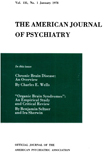Directional effects of skin temperature self-regulation on regional cerebral blood flow in normal subjects and migraine patients
Abstract
Vascular headache of the migraine type is associated with vasomotor changes in cerebral arteries. The authors studied whether skin temperature training (biofeedback) reduces the frequency, severity, and duration of these headaches by measuring the regional cerebral blood flow in 11 migraine patients and 9 normal volunteers using the noninvasive 133Xe inhalation technique. Half of each group was randomly assigned to a hand-warming or a hand-cooling group. Cerebral blood flow increased in several regions of the left hemisphere to a statistically significant degree only for the migraineurs who were in the hand- warming group. The pattern of vasomotor regulation apparently differs between migraine subjects and normal subjects. The migraineurs' headache symptoms were affected by both warming and cooling, but warming produced more salutary effects.
Access content
To read the fulltext, please use one of the options below to sign in or purchase access.- Personal login
- Institutional Login
- Sign in via OpenAthens
- Register for access
-
Please login/register if you wish to pair your device and check access availability.
Not a subscriber?
PsychiatryOnline subscription options offer access to the DSM-5 library, books, journals, CME, and patient resources. This all-in-one virtual library provides psychiatrists and mental health professionals with key resources for diagnosis, treatment, research, and professional development.
Need more help? PsychiatryOnline Customer Service may be reached by emailing [email protected] or by calling 800-368-5777 (in the U.S.) or 703-907-7322 (outside the U.S.).



